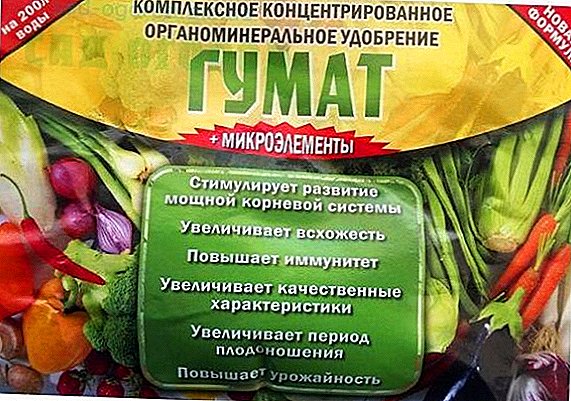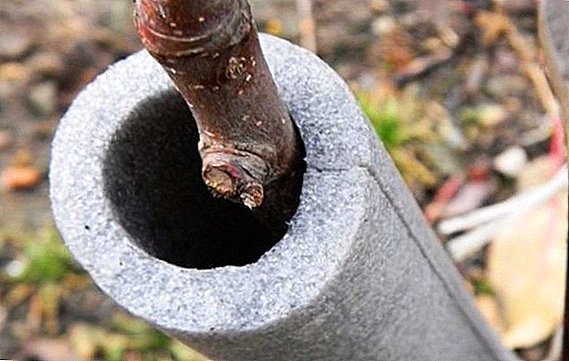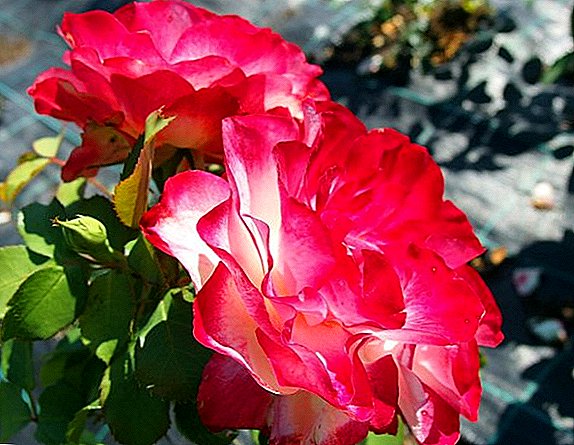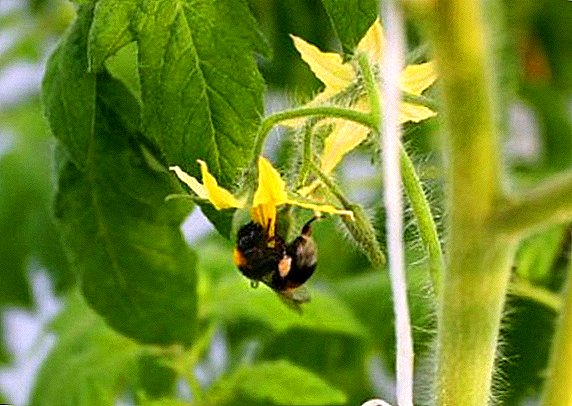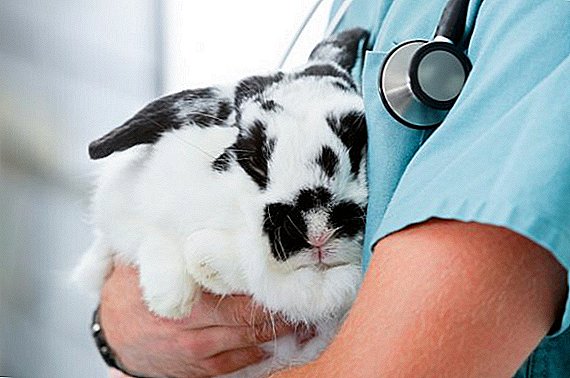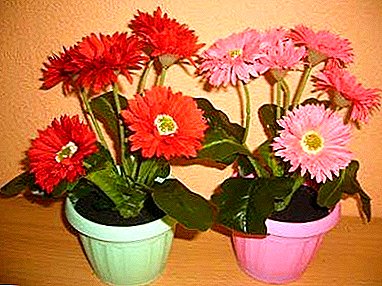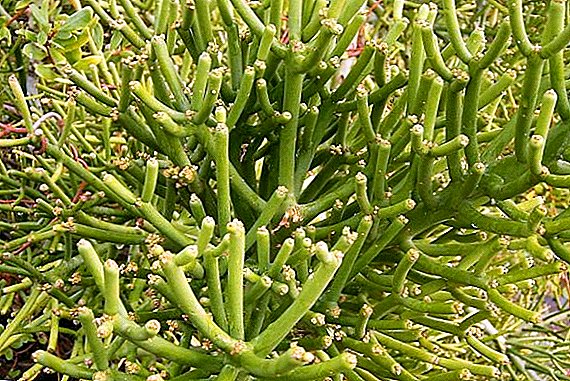 In nature, Euphorbia "Tirukalli" can grow up to 9 meters, but as for a houseplant, its growth is limited by its capacity and pruning. In our country, amateur growers began to call this original plant a “naked peasant” or “pencil tree”. We learn what Euphorbia represents, Tirukalli, how to grow and multiply it, and what problems can be encountered.
In nature, Euphorbia "Tirukalli" can grow up to 9 meters, but as for a houseplant, its growth is limited by its capacity and pruning. In our country, amateur growers began to call this original plant a “naked peasant” or “pencil tree”. We learn what Euphorbia represents, Tirukalli, how to grow and multiply it, and what problems can be encountered.
Botanical characteristics of the plant
Euphorbia "Tirukalli" refers to the genus and family of the same name. It is also known as rubber-moth euphorbia or euphorbia tirukalli. It is a perennial tree plant growing to 5-9 m. This succulent is very branch thin, only 5-7 mm thick, with branches. They have a cylindrical shape and juicy green color. At their ends grow small, inconspicuous leaves up to 12 mm long and about 1 mm wide. When these leaves fall, they leave point marks on the tips of the branches. 
The plant blooms with small yellow flowers, but in room conditions it happens very rarely. After flowering smooth three-blade hazel are formed. Refers to dioecious plants.
Did you know? In the old days, euphorbia "Tirukalli" was used in industry for rubber. Now it is extracted from the poison for the fish.Widely distributed throughout the African continent and nearby islands, in Madagascar, it is found on the Arabian Peninsula, and has taken root in other parts of the world.
Ways to grow and care at home
When growing milkweed "Tirukalli" it should be borne in mind that it grows quickly and requires a lot of space. Usually at home he reaches a meter. However, if the plant is not cut and grow in large capacity, it can reach a larger size. In greenhouse conditions in the tub grows to 6 m. In general, it is simple to grow and belongs to the unpretentious indoor plants and grows well in offices.

Accommodation
This is a tropical plant from Africa, loving sunlight. He is well suited southern windows. There, during the hot sun, it is recommended to pritenyat. If this is not done, this euphorbia will still feel normal to itself, but will acquire a yellowish color. On the windowsills of the eastern or western direction, euphorbia will retain bright green tones and feel comfortable. It normally carries a penumbra, but thick shading causes the plant to stretch too much and lose its decorative appearance.
In the summer, it is permissible to take it out to well-lit verandas, terraces and a balcony. At the same time, it is required to exclude precipitation hit on it, a strong decrease in temperatures and drafts.
Important! The milky juice of euphorbia is very poisonous, so it should be kept out of the reach of children and animals. If it gets on the skin, it causes a severe burn, and if it gets into your eyes, you can be left without sight, and everything can manifest itself not immediately, but in a few hours.
Temperature and humidity
The optimum temperature during the growing season (spring-autumn) will be when it is + 25 ° C during the day and + 20 ° C at night. In winter, when this succulent in nature has a dormant period, the temperature somewhat decreases, but in no case is below + 12 ° C, otherwise the plant may die. It is better if the winter temperatures will be at + 15 ... + 18 ° С. These same temperature indicators should be maintained if the plant is carried to fresh air.
Dry air plant tolerates normal and does not require spraying. For specimens that have reached a decent size in a warm period, it is recommended to arrange a shower to get rid of dust. Then the plant should be in a warm, well-lit place without drafts before drying. Young copies can be cleaned with a soft brush.

Irrigation methods
Like all succulents, this type of milkweed is able to accumulate water in itself and tolerates drought well. Due to this, it can exist for some time in over-dried soil. It is better to forget to water it than to overwet it. Excess moisture for him is harmful, because it leads to rotting of the roots. During the growing season, moderate watering is carried out under the root, and always drain water from the pan. In the warm season, they are made no more than once a week. In the winter season, they are reduced to 1 time per month and watered poorly.
Watering is required to carry out soft, well-settled water.
Top dressing
Feed in the active period of development in the spring about 1-2 times. Fertilizers for cacti or succulents containing predominantly potassium are ideal for this. For feeding you can use the ash solution - succulents love it, because it contains potassium and phosphorus. For an adult plant, you can use egg shells. For this, it is crushed and applied to the soil, but do not be very zealous - it alkalizes the soil a little.
Important! Excess fertilizer, especially nitrogen, can adversely affect the milk and cause its death.
Transfer
For the first time, newly bought spurge is transplanted - within ten days after purchase.
The process itself occurs in the following sequence:
- Prepare a pot for planting. He must have a hole to drain.
- At the bottom it is necessary to lay out a drainage layer of gravel or pebbles.
- Take the soil for planting. It can be purchased at the store, and you can cook yourself. Perfect for planting a mixture of equal parts of turf, river sand and garden land.
- Put some soil in the pot on top of the drainage layer.
- Carefully remove Euphorbia from the container and center it in a pot for planting. Then gently cover the soil, slightly tamping it.
As they grow, when the roots become crowded in the pot, the plant is transplanted. This usually happens every few years. The pot for transplanting choose a little large size.
Reproduction by cuttings
Euphorbia "Tirukalli" multiplies mainly by grafting. The plant still periodically requires pruning, and pruning is great for rooting. This process is best done in the spring. They use a sharp knife or scissors, which must be disinfected beforehand. For planting choose a deep and wide pot with thick walls. There must be holes in the pot to remove excess liquid. Too large a pot does not need to take, it must fit the size of the plant. 
The process of propagation by cuttings occurs in the following sequence:
- Cut off the tops of the parent plant with branches.
- Place the cuttings in warm water so that the juice can flow out.
- Leave the cuttings in a shaded place for 24 hours to dry the cut.
- It is desirable to process the cut with a special phytohormone or activated carbon powder.
- At the bottom of the pot should be placed a drainage layer of expanded clay or pebbles.
- Place wet peat in the tank for planting, and pour clean river sand on top.
- Planted cuttings are prepared in the prepared soil so that the end of the cutting reaches the peat layer. To bush milkweed lush, in one pot is recommended to plant several cuttings.
- Then do moderate watering and move the container with planting to a warm enough place, as well as a place well-lit by the sun.
- To speed up the rooting process, you can create a greenhouse effect. To do this, the container with the landing covered with a plastic bag.
Every day it should be opened for airing and moistening. The soil should not dry out, but it should not be allowed to overflow.
Important! During the procedure of grafting hands, it is imperative to protect from poisonous juice from rubber gloves, and after carrying out the process, wash your hands thoroughly with soap and water.
Possible difficulties in growing
When growing milkweed "Tirukalli", you may encounter some problems. So, overflows and excess moisture, as well as hypothermia and other violations in the care of this indoor flower can cause the appearance of a number of diseases.
Consider the main ones:
- Root decay. It is necessary to transplant the flower in another pot with the replacement of the soil. In the tank for planting must be drainage. When transplanting should be carried out removal of rotten roots. Slices should be treated with activated carbon powder.
- The stems become brown in color and become soft in structure.. This process is due to hypothermia when temperatures have dropped below the critical point. Unfortunately, in this case, the plant can not be saved.
- The leaves turn yellow. This is often due to direct hitting of the sun on the plants. In this case, you need shading.

Dry indoor air may contribute to the following pests:
- Mealybug. It is detected in the form of a white vatoobraznogo plaque. It can be removed with a piece of cloth dipped in alcohol. Damaged areas of the plant should be trimmed.
- Spider mite. You can identify the pest by the appearance of the thinnest web and white blotches. To combat it, increase the humidity in the room, and clean the plant with soapy water. It should also apply the chemical agent "Aktara".
- Aphid. You can remove pests mechanically or with soapy water. For severe lesions, the Fufanon or Actellic chemical preparations are used.
Did you know? In the 80s of the last century, chemist Melvin Calvin suggested that oil could be obtained from the milk of Tirukalli. The Petrobras oil company (Brazil) began research that was unsuccessful.
Euphorbia "Tirukalli" unpretentious, grows quickly, is easily grown and multiplies, and if you provide him with proper care and comfortable conditions for growth, he will not be afraid of any problems. The main thing is not to overwet the soil for him.



